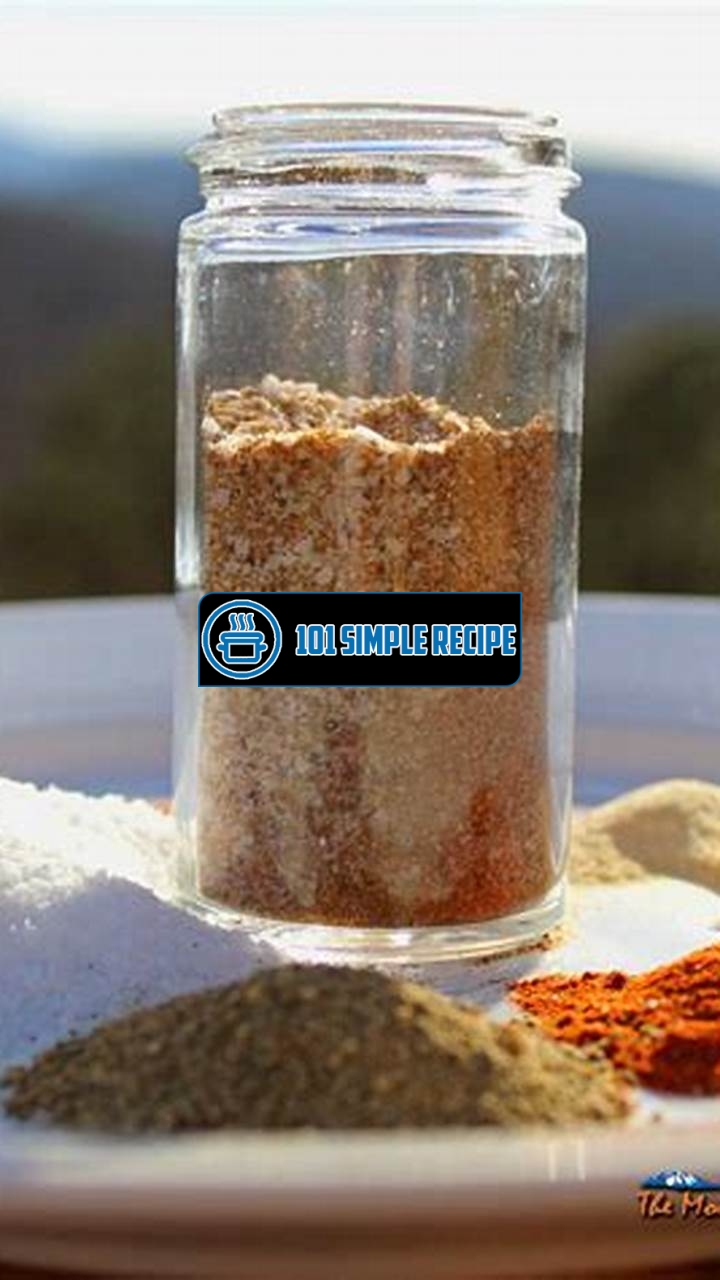Elevate Your Dishes with Homemade Seasoning Salt

If you’re tired of the same old bland flavors in your dishes, it’s time to take matters into your own hands and create your own homemade seasoning salt. Not only will it add a burst of flavor to your meals, but it will also give you full control over the ingredients and ensure that you know exactly what goes into your food. With just a few simple ingredients, you can create a versatile and delicious homemade seasoning salt that will elevate your cooking to a whole new level. So put on your apron, grab your spices, and let’s get started!
The Basics of Homemade Seasoning Salt
Are you tired of using store-bought seasoning salt that lacks flavor and freshness? It’s time to elevate your dishes with homemade seasoning salt. By exploring the world of homemade seasoning salt, you can discover its many advantages over the pre-packaged options available in supermarkets.
The Benefits of Making Your Own Seasoning Salt
When you choose to make your own seasoning salt, you are in control of the ingredients and can customize the flavor to suit your taste buds. Unlike store-bought options that often contain additives and preservatives, homemade seasoning salt allows you to use natural and high-quality ingredients.
Making your own seasoning salt also gives you the flexibility to experiment with different flavor combinations. Whether you prefer a spicy kick, a savory blend, or a tangy twist, the possibilities are endless. You can enhance the taste of your dishes by adding your favorite herbs, spices, and even dried fruits to your homemade seasoning salt.
Furthermore, homemade seasoning salt can be a healthier alternative as you can reduce the amount of sodium and control the use of artificial flavor enhancers. By using fresh and natural ingredients, you can elevate the nutritional value of your dishes without compromising on taste.
Common Ingredients Used in Homemade Seasoning Salt
Creating your own seasoning salt is a fun and creative process. While the specific ingredients may vary depending on personal preferences, there are some common staples you can include to enhance the flavor of your dishes.
One essential ingredient is salt, which acts as a base for seasoning salt. You can choose from a variety of salts, including sea salt, Himalayan pink salt, or even flavored salts to add an extra dimension of taste. It’s important to keep in mind that some salts are stronger than others, so adjust the quantity accordingly.
In addition to salt, herbs and spices are crucial components of homemade seasoning salt. Popular choices include garlic powder, onion powder, paprika, black pepper, and dried herbs like thyme, rosemary, and oregano. Feel free to experiment with different combinations and proportions to create a unique blend that suits your preferences.
For those who enjoy a bit of heat, adding chili powder or cayenne pepper can bring a spicy kick to your seasoning salt. Adding a touch of sweetness can be accomplished by including ingredients like brown sugar or dried fruits such as lemon zest or dried orange peel.
Tools and Equipment Needed for Making Seasoning Salt
Making your own seasoning salt doesn’t require fancy tools or equipment. In fact, you probably already have everything you need in your kitchen. Here are the basic tools and equipment needed:
- A mixing bowl to combine all the ingredients.
- A whisk or fork to ensure the ingredients are evenly mixed.
- A grinder or mortar and pestle to grind whole spices or herbs, if desired.
- Airtight containers to store your homemade seasoning salt and preserve its freshness.
With these simple tools, you are ready to embark on your journey of creating delicious and flavorful homemade seasoning salt.
Note: Remember to taste test your seasoning salt along the way to ensure it meets your desired flavor profile. Adjust the ingredients as needed to achieve the perfect balance.
By mastering the art of homemade seasoning salt, you can take your dishes to a whole new level. Say goodbye to store-bought options and hello to a world of endless flavor possibilities. Get creative in the kitchen and enjoy the satisfaction of elevating your culinary creations with your own homemade seasoning salt.
Creating Your Signature Seasoning Blend
Unleash your creativity by learning how to mix and match ingredients to create a unique flavor profile for your seasoning salt. With homemade seasoning salt, you have the opportunity to customize the taste and intensity to perfectly complement your dishes. Whether you prefer a tangy, spicy, or savory blend, follow these steps to create a seasoning salt that will elevate the flavor of your meals to a whole new level.
Choosing the Base Salt for Your Seasoning Blend
The base salt forms the foundation of your homemade seasoning blend. It provides the primary flavor and determines the overall saltiness of your seasoning salt. There are several types of salt you can choose from, each with its own distinct characteristics.
1. Kosher Salt: Known for its large, coarse crystals, kosher salt is a popular choice for seasoning blends. It dissolves easily and adds a subtle touch of saltiness to your dishes.
2. Sea Salt: Derived from evaporated seawater, sea salt offers a variety of textures and flavors depending on its source. It can range from fine and delicate to chunky and briny, allowing you to experiment with different levels of saltiness.
3. Himalayan Pink Salt: Mined from ancient salt deposits in the Himalayan mountains, this salt is known for its pink hue and high mineral content. It adds a mild, earthy flavor to your seasoning salt.
4. Smoked Salt: Made by slowly smoking sea salt over aromatic woods, smoked salt imparts a rich and smoky flavor to your dishes. It works particularly well with grilled or barbecued meats.
Adding Herbs and Spices to Enhance Flavor
To create a truly unique seasoning blend, incorporate a variety of herbs and spices into your salt mixture. The possibilities are endless, but here are a few popular combinations to get you started:
Note: Don’t be afraid to experiment and adjust the measurements to suit your taste preferences. The amounts listed here are just suggestions.
1. Italian Herb Blend: Combine dried basil, oregano, thyme, rosemary, and garlic powder for a versatile seasoning that pairs well with pastas, pizzas, and roasted vegetables.
2. Smoky Chipotle Spice: Mix smoked paprika, chipotle powder, cumin, garlic powder, and onion powder for a spicy and smoky flavor. This blend works wonders on grilled meats and in Tex-Mex dishes. ️
3. Tangy Lemon Herb: Blend dried lemon zest, thyme, parsley, and black pepper to create a zesty and refreshing seasoning. It’s perfect for seafood, chicken, or even sprinkling on salads.
Experimenting with Heat and Sweetness
If you enjoy a touch of heat or sweetness in your dishes, don’t be afraid to incorporate these elements into your seasoning salt. Consider adding ingredients such as crushed red pepper flakes, cayenne pepper, paprika, or brown sugar to create a well-rounded flavor profile. Remember to start with small amounts and adjust according to your taste preferences.
1. Spicy Kick: If you love a fiery kick, experiment with adding crushed red pepper flakes, cayenne pepper, or even a pinch of ghost pepper powder to your seasoning salt. It’s perfect for adding heat to grilled meats or spicing up sauces and dips. ️
2. Sweet and Savory: For a unique twist, try combining brown sugar, paprika, garlic powder, and a hint of cinnamon in your seasoning salt. This blend adds a touch of smoky sweetness to roasted vegetables, glazed meats, or even barbecue sauces.
With these tips in mind, you’re ready to embark on a flavorful journey of creating your very own homemade seasoning salt. Remember to have fun, experiment with different combinations, and adjust the measurements to suit your taste. Elevate your dishes by adding a personal touch of flavor with your signature seasoning blend!
If you’re in the mood for something sweet, you can try this peanut butter cup recipe. It’s a classic treat that combines the rich flavors of chocolate and peanut butter for a delicious indulgence.
Mastering the Art of Seasoning
When it comes to creating delicious dishes that leave your taste buds wanting more, mastering the art of seasoning is crucial. And one way to take your culinary creations to the next level is by using homemade seasoning salt. With just a few expert tips and techniques, you can elevate the flavors of your dishes and impress your family and friends with your culinary skills.
Understanding Proper Seasoning Techniques
Proper seasoning is all about finding the right balance of flavors to enhance the taste of your dish. When using homemade seasoning salt, it’s important to remember a few key techniques:
- Layering Flavors: One of the secrets to great seasoning is layering flavors. Start by adding a pinch of seasoning salt during the cooking process and taste as you go. This allows you to build flavors gradually, ensuring that each ingredient enhances the overall taste.
- Seasoning in Stages: Different ingredients have different cooking times, which means they require seasoning at different stages. For example, when making a soup, you may want to season the broth first and then adjust the seasoning once all the ingredients are added. This helps to prevent over-seasoning and allows the flavors to develop more harmoniously.
- Using Fresh Ingredients: The quality of your ingredients plays a crucial role in the final outcome of your dish. Using fresh herbs and spices can elevate the flavors of your homemade seasoning salt and make a noticeable difference in the taste.
By mastering these proper seasoning techniques, you can ensure that your homemade seasoning salt enhances the natural flavors of your dishes and creates a delightful dining experience for everyone.
Using Seasoning Salt in Various Types of Dishes
Homemade seasoning salt is a versatile ingredient that can be used in a wide range of dishes. Whether you’re cooking meat, poultry, seafood, or vegetables, seasoning salt can add depth and complexity to your recipes. Here are a few ideas to get you started:
- Grilled Steak: Sprinkle a generous amount of homemade seasoning salt on both sides of your steak before grilling it to perfection. The seasoning salt will help to enhance the natural flavors of the meat and create a delicious crust.
- Oven-Roasted Vegetables: Toss your favorite vegetables in olive oil and sprinkle them with homemade seasoning salt before roasting them in the oven. The seasoning salt will infuse the vegetables with a savory flavor and make them irresistibly tasty.
- Seared Salmon: Coat your salmon fillets with a thin layer of homemade seasoning salt before searing them in a hot pan. The seasoning salt will help to bring out the flavors of the fish and create a crispy, flavorful crust.
These are just a few examples of how you can use homemade seasoning salt to elevate the taste of your dishes. Feel free to experiment with different ingredients and recipes to discover your own unique flavor combinations.
Exploring Unconventional Uses for Seasoning Salt
While homemade seasoning salt is commonly used in savory dishes, it can also add a surprising twist to unexpected recipes. Here are a few unconventional uses for seasoning salt that you might not have considered:
- Popcorn Seasoning: Instead of using plain salt on your popcorn, try sprinkling it with homemade seasoning salt. It will give your popcorn a burst of flavor and take your movie nights to a whole new level.
- Chocolate-Dipped Pretzels: Enhance the sweet and salty combination of chocolate-dipped pretzels by sprinkling them with a pinch of homemade seasoning salt. The contrast of flavors will tantalize your taste buds.
- Watermelon Salad: Give your refreshing watermelon salad an unexpected twist by adding a sprinkle of homemade seasoning salt. The saltiness will enhance the sweetness of the watermelon and create a unique flavor profile.
By exploring unconventional uses for seasoning salt, you can add an exciting twist to your favorite recipes and surprise your guests with unexpected flavor combinations.
If you want to make your own homemade seasoning salt, you can check out this oyster cracker ranch recipe for inspiration. It’s a delicious snack that you can enjoy on its own or use as a topping for salads and soups.
Storing and Preserving Your Seasoning Salt
Elevating your dishes with homemade seasoning salt is a great way to add a burst of flavor to your meals. But once you’ve made your seasoning salt, how do you store it to ensure its freshness and quality? In this section, we’ll explore the best practices for storing and maintaining the integrity of your homemade seasoning salt.
Choosing the Right Container for Storage
When it comes to storing your homemade seasoning salt, the choice of container plays a crucial role. You want a container that is airtight and able to keep out moisture and air. This will help preserve the flavor and prevent clumping. Here are some container options to consider:
- Glass Jars: Glass jars with tight-fitting lids are an excellent choice for storing seasoning salt. They are non-reactive, meaning they won’t interact with the spices, and they provide a barrier against moisture.
- Plastic Containers: If you prefer a lightweight option, food-grade plastic containers can also work well. Look for containers with airtight seals to ensure freshness.
- Spice Containers: Another option is to use spice containers with shaker tops. These are handy for easy sprinkling of your seasoning salt onto dishes. Just make sure the tops are airtight to prevent clumping.
Preventing Moisture and Clumping
Moisture is the enemy of seasoning salt, as it can cause the spices to clump together and lose their potency. To prevent moisture and clumping, consider the following tips:
- Add a Desiccant: Placing a desiccant packet in your seasoning salt container can help absorb any moisture that may be present. You can find desiccant packets online or in stores specializing in packaging supplies.
- Avoid Moisture-Prone Areas: Store your seasoning salt in a cool, dry place away from direct sunlight, stoves, and sinks. Avoid storing it near other moist ingredients in your pantry to minimize the risk of moisture absorption.
- Use Anti-Caking Ingredients: Some recipes for homemade seasoning salt include anti-caking ingredients such as rice flour or cornstarch. These ingredients help prevent clumping by absorbing moisture. Ensure the container is properly sealed to retain the effectiveness of these ingredients.
Extending the Shelf Life of Seasoning Salt
With proper storage and handling, you can extend the shelf life of your homemade seasoning salt. Here are some additional tips to keep in mind:
- Label and Date: Always label your seasoning salt container with the date of preparation. This will help you keep track of its freshness and determine when it’s time to make a new batch.
- Avoid Contamination: Always use a clean and dry spoon or measuring spoon when scooping out seasoning salt. This prevents contamination and the introduction of moisture into the container.
- Regularly Check for Freshness: Spices lose their flavor over time, so it’s essential to regularly check the freshness of your seasoning salt. If the aroma and flavor have significantly diminished, it’s time to make a new batch.
Following these best practices for storing and preserving your homemade seasoning salt will ensure that it remains fresh, flavorful, and ready to elevate your dishes. Enjoy experimenting with different spice blends and discovering new flavor combinations!
Sharing Your Homemade Seasoning Salt Creations
Discover creative ways to share your homemade seasoning salt and spread the joy of flavorful dishes.
Presenting Your Seasoning Salt as a Gift
One of the most delightful ways to share your homemade seasoning salt is by presenting it as a gift. Whether it’s for a special occasion or just a thoughtful gesture, giving your seasoning salt as a gift allows others to experience the flavors and creativity you put into your homemade creations.
To make your gift even more special, consider packaging your seasoning salt in a beautiful jar or container. This adds a touch of elegance and shows that you’ve put thought and effort into the presentation. You can choose from a variety of jars and containers, such as glass jars with cork lids or small mason jars tied with a ribbon.
Another way to enhance the presentation is by including a personalized label or tag. You can create custom labels using your computer or even handwrite them for a personal touch. Include the name of the seasoning salt, a brief description, and maybe even a suggested recipe or usage idea. This not only adds a professional touch but also provides the recipient with some inspiration on how to use the seasoning salt.
Creating Custom Labels and Packaging
If you want to take your homemade seasoning salt to the next level, consider creating custom labels and packaging. This not only adds a professional and polished look to your creations but also makes them more memorable and unique.
️ Designing custom labels allows you to showcase your creativity and attention to detail. You can use design software or online templates to create labels that reflect your personal style or the essence of the seasoning salt. Include eye-catching graphics, elegant fonts, and enticing descriptions to pique the interest of anyone who sees your seasoning salt.
When it comes to packaging, think outside the box. Consider using unconventional materials such as fabric pouches, small wooden boxes, or even recycled materials like glass jars or tins. The packaging should align with the theme or flavors of the seasoning salt, creating a cohesive and visually appealing presentation.
Sharing Recipes and Ideas with Others
Sharing recipes and ideas with others is an excellent way to spread the joy of flavorful dishes and inspire creativity in the kitchen. When it comes to homemade seasoning salt, there are endless possibilities for sharing your knowledge and expertise.
️ One way to share your recipes is by hosting a seasoning salt tasting party. Invite friends, family, and fellow food enthusiasts to sample your various seasoning salt creations. Provide small dishes, crackers, or bread for guests to try the different flavors. Encourage them to take notes and share their favorite pairings or recipe ideas.
Another approach is to create a recipe blog or social media account dedicated to homemade seasoning salts. Share your favorite recipes, usage tips, and even video tutorials. Engage with your followers by encouraging them to share their own seasoning salt creations or ask questions about yours. This creates a community of seasoning salt enthusiasts who can learn from and inspire each other.
In conclusion, sharing your homemade seasoning salt creations is not only a generous and thoughtful gesture, but it also allows others to experience the joy of flavorful dishes. Whether you present it as a gift, create custom labels and packaging, or share your recipes and ideas, the possibilities are endless. So go ahead and elevate your dishes with homemade seasoning salt and share the love!
Looking for a tasty seasoning blend to spice up your meals? Try this ranch oyster crackers recipe. It’s a simple and flavorful combination of spices that will take your dishes to the next level.
Thank you for taking the time to read our article on homemade seasoning salt. We hope you found it informative and inspiring. Making your own seasoning salt is not only a fun and creative process, but it also allows you to have complete control over the flavor profile of your dishes. So why not give it a try and add a touch of homemade goodness to your meals?
If you have any further questions or would like to share your own seasoning salt recipes with us, please feel free to leave a comment below. And don’t forget to bookmark our website and visit us again later for more exciting recipes and cooking tips. Happy seasoning!
Frequently Asked Questions
Here are some frequently asked questions about homemade seasoning salt:
| No. | Questions | Answers |
|---|---|---|
| 1. | Is homemade seasoning salt healthier than store-bought versions? | Yes, homemade seasoning salt allows you to control the amount of salt and other ingredients, making it a healthier option compared to some store-bought versions that may contain added preservatives and artificial flavors. |
| 2. | Can I customize the flavors in homemade seasoning salt? | Absolutely! One of the great things about making your own seasoning salt is that you can tailor it to your taste preferences and experiment with different combinations of herbs and spices. |
| 3. | How long does homemade seasoning salt last? | When stored in an airtight container in a cool, dry place, homemade seasoning salt can last for several months. However, for best flavor and potency, it is recommended to use it within 3-6 months. |
| 4. | Can I use homemade seasoning salt on any type of dish? | Yes, homemade seasoning salt is versatile and can be used on a wide variety of dishes, including meats, vegetables, soups, and even snacks like popcorn. |
| 5. | Are there any specific safety precautions when making homemade seasoning salt? | It is important to use clean utensils and containers when making homemade seasoning salt to prevent contamination. Additionally, make sure to label your seasoning salt with the date of preparation and ingredients used to avoid confusion. |
| 6. | Can I adjust the level of saltiness in homemade seasoning salt? | Yes, you can adjust the amount of salt in homemade seasoning salt based on your preference. If you prefer a lower sodium option, you can reduce the amount of salt and increase the proportion of other herbs and spices. |
Homemade Seasoning Salt Recipe
Here is a simple and delicious recipe for homemade seasoning salt:
Jump to Recipe
Homemade Seasoning Salt

Learn how to make your own flavorful seasoning salt at home. Customize the flavors and enjoy the freshness of homemade seasonings.
- 1/4 cup sea salt
- 1/4 cup paprika
- 2 tablespoons garlic powder
- 1 tablespoon onion powder
- 1 tablespoon dried oregano
- 1 tablespoon dried thyme
- 1 tablespoon dried basil
- 1 tablespoon black pepper
- 1 teaspoon cayenne pepper (optional)
- In a bowl, combine all the ingredients until well mixed.
- Transfer the mixture to an airtight container and store in a cool, dry place.
- Use as desired to season various dishes.






